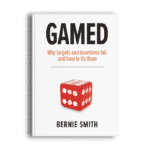
OKR Key Results: How to set effective OKR targets in 10 steps
So, you've been tasked with setting some OKR targets, huh? Don't fret, my friend, we've got you covered! The OKR (Objectives and Key Results) framework is the secret sauce for effective goal-setting, and when done well, OKRs help create a culture of accountability and engagement. However, the approach can quickly become prickly when it comes to OKR targets.
If you're looking more for a complete guide to the OKR framework, we have one that will give you details across the benefits of the OKR approach right through to 20 examples of good objective key results across an array of industry teams, and it will show you how to create OKRs for your team that will drive success.
But beware - it's vital to ensure that the OKRs you have set up have carefully crafted key results with targets and incentives that can't be gamed. What is gamed, you ask? It's when someone achieves a target by deceptive means, thus gaining the reward without the desired result. If you'd like to avoid this in your OKRs, keep reading as we teach you exactly how to set effective OKR targets in 10 steps with a free downloadable template to boot.
Key concept: What is an OKR?
If you haven’t come across them already OKR is a goal-setting approach pioneered in Intel, based on Peter Drucker’s work on Management by Objectives in the 1950s, which is now used widely across the corporate world.
OKR stands for ‘Objective Key Results’.
The Objective element describes a substantial, often long-term outcome we want to achieve.
Key concept: What is a Key Result?
The Key Result is a smaller outcome, a stepping stone goal, that will help us reach that big 'Objective'.
A personal OKR example
Objective: Give up smoking
Key Result: Go 10 days without a cigarette
A corporate OKR example
Objective: Quadruple online sales
Key Results: Grow email list to 50k subscribers
Key concept: OKRs vs KPIs
OKRs are not to be confused with KPIs, which stands for key performance indicators. The main difference is that OKRs help set goals and plan how to track them, while KPIs are the actual measurements used to see if the goals are being met.
To illustrate, imagine I'm a smoker and I'm trying to quit. My objective might be to “Give up smoking cigarettes forever”.
A key result that will help me achieve that might be “To not smoke a cigarette for seven days".
My KPI for that period would be "Number of cigarettes smoked" with a KPI target of zero cigarettes.
Key Performance Indicators are simply the facts of the situation. Targets, Key Results and Objectives help give those facts context and generate motivation.
Importance of OKR target setting
At Made to Measure KPIs, we believe that the importance of OKR target setting is paramount. If you're interested in learning more about why targets and incentives fail and how to fix them, check out Bernie Smith's book, GAMED. The book delves into the intricacies of performance measurement and management, underscoring how effective OKR target setting can revolutionise an organisation's approach to achieving its goals.
Bernie emphasises that OKR target setting is not just about establishing ambitious objectives; it's about aligning these objectives with measurable, impactful results. This alignment is crucial for organisations seeking to navigate the complex landscape of modern business, ensuring that every team member's efforts contribute meaningfully towards overarching strategic goals. Thus, the importance of OKR target setting, as highlighted in GAMED, lies in its ability to provide clarity, focus, and a roadmap for success in a highly competitive and dynamic environment.
If you're looking for objectives and key results online training, look no further! Our on-demand targets and key results course, also titled GAMED after the book, will get you up to speed with how to successfully design and use OKRs and how to craft those all-important targets and incentives. This is the only OKR training program online you'll ever need.
Example of problematic targets and key results
To illustrate the importance of well-design OKR targets, we'll use a fictional example concerning the fictional call centre company, Roughshod Repairs. To handle rising call volumes, Roughshod Repairs recruited more agents and set an agrressive 'Average Handling Time' (AHT) target of 15 calls per hour. Agents were incentivised by getting a 30% bonus for hitting targets.
Initially call volumes skyrocketed, but soon, so did the volume of complaints from unhappy customers. They complained of rushed cut-off calls. Management of Roughshod decided to investigate the situation by chatting to their agents first. These chats revealed that after the incentive program was launched, agents felt extremely pressured to meet the targets which resulted in stress and resorting to gaming the system.
They expressed that they were not getting enough time to wrap up calls properly and write notes, which was having a knock-on effect on customers calling back. In addition to the general dissatisfaction, some of the agents had noticed that they could improve their AHT by switching the status of their call system to 'Mandatory Training' whilst writing up notes or taking a bathroom break as this category was excluded from the calculation of AHT.
After this, management decided to make a list of the current situation and issues.
Current situation:
- AHT target is 15 calls per hour
- Agents get a 30% bonus if they meet or exceed their AHT target
Issues:
- Calls being cut off
- Rushed calls
- Create an unnecessary action for the customer to end the call
- Pass the customer off to another team, even it's not appropriate
- Not recording call notes properly in the system
- Pattern of unresolved customer issues
- Gaming of system status codes to take breaks
- Complaints from customers
- Agent frustration
This example shows how rigid incentive systems can undermine quality and sustainability. Targets and rewards need balanced design with unintended consequences in mind.

How to set effective OKR targets in 10 steps
Let's get into how to set effective OKR targets. Along with our 10 step guide on how to create OKRs in general, Bernie has also designed the ROKET-DS system. This system is a complete approach to designing effective targets and key results and it can be done in 10 simple steps. Here's an overview of those steps below.

Here's a quick introduction and some resources on each of those 10 key result design steps...
Step 0: Identify existing issues
This is a zero step because it can be optional - in some scenarios, you will not have existing targets. If that's the case, you could skip on to Step 1. However, if you do have existing targets in place, you might be struggling with targets that are not driving the right results or are fueling poor behaviour. Here it’s important to have a full understanding of the issues. This will give us important input when we come to test our revised targets.
In this step, we research and record:
- What existing targets and incentives do we already have in place?
- What side-effects, symptoms and problems do we experience with our existing targets and incentives?
- Review the hard issues, for example lost income, time or product
- Don't forget to review the soft issues, for example reduced moral, frustration and damaged reputation
Step 1: Plan outcome
Without a clear picture of what outcomes we are looking for, we are doomed to failure. We need to clearly and precisely define the outcome we are looking for, avoiding vague, ‘woolly’ words that can lead to misunderstanding and confusion. Having an eye on the fundamental goal, or strategic goal if you like, helps us stop becoming obsessed with lower-level outcomes that perhaps don't deliver the expected higher-level outcome. In this step we ask:
- What high-level outcome do we want?
- Why is this outcome important?
Over years of experience, Bernie has discovered six core strategic business goals that come up across almost every business. These goals, nicknamed the Big 6, can be found in any of Bernie's books and courses.
Step 2: Match KPIs
It can be very dangerous to target a single metric or KPI, as human nature is to focus intensely on measures which are targeted and rewarded, often to the detriment of other important outcomes.
An example of this risk is the common situation of a sales professional selling extra unwanted products to customers in exchange for a discount on their intended purchase, on the agreement that they can return the extra products after month end (and sales bonus payment based on sales revenue).
The solution to this challenge is to use a KPI Tree to create a balanced set of KPIs to target. You can access our ultimate guide to building killer KPI trees for free on our website. So Step 2 will involve using KPI trees to:
- Identify the KPIs that will tell you whether you are moving towards your planned outcome.
Step 3: Identify and engage target owners
It is critical that we identify the owners and managers of our planned targets or key results, so we can…
- Understand who has control or influence over the KPIs identified in Step 2
- Who can directly influence the KPIs in Step 2?
- Who can control resources, systems or inputs to the KPIs in Step 2?
- Who provides relevant support, training, feedback, policing, or quality management relevant to the KPI performance?
- Assess owner ‘agency’ in the next step
- Involve a sample of that group in both testing steps
- Build full engagement and buy-in for the planned targets and key results
Step 4: Check owner agency
The word ‘agency’ describes whether a target owner is fully equipped to attempt to hit, or exceed, the planned target. There is little point in setting a target that is completely unobtainable. Doing so, particularly if you then add strong incentives, can lead to dangerous behaviours ranging from cheating through to blatant criminality. It can also lead to team stress, anxiety and attrition.
This step involves answering the following question: does the target owner have the necessary...
- Skills
- Time
- Authority
- Resources
...to move towards the target?
Step 5: Draft target values and rules
Once we have the ‘basket’ of KPIs that we need to develop targets and key results for, we need to decide on the draft values and timescales. This discussion will involve considering:
- The meaning and impact of the planned outcomes from achieving the targets
- The practicalities of achieving those results
- The relationship of those targets with incentives (if we intend to link these targets/key results to rewards/punishment)
Our outputs from this stage are:
- Target values
- The 'rules' for achieving targets
Step 6: What hat test targets
With any system of targets or key results, there is an ‘intended’ way in which they should operate.
For example, a sales target may be intended to work in the following way:
- We set a stretch target for each sales team member
- The sales team increase their activity and/or conversion rate
- We see an uplift in the sales margin in line with (or exceeding) the stretch target
- The sales, margin and profit of our business increases in line with the stretch targets
At this step, we simply think about how things should work, not about the ways in which people might game the system or do unexpected things - that comes in the next step.
Step 6 can be summarised by the following question: 'What should happen when people display the behaviours we expect and encourage?'
Step 7: Black hat test targets
Humans are highly sophisticated at maximising the personal benefit from any situation. Anyone who has played a board game with beloved family members will have rapidly discovered just how devious and ingenious those family members can be. Many targets and key results are launched without proper testing.
In this step, we gather a sample of the target-owning stakeholders and ‘reverse brainstorm’ how the target/key result could be ‘achieved’ but with the worst possible real-world outcome. Doing this enables us to fix the design issues before any failings lead to operational or PR catastrophe.
Step 7 involves the following:
- Reverse brainstorm how to hit targets in the worst possible way
- Apply the ROKET-DS Diagnostic which is available within the GAMED online course or book
Step 8: Fix problems and re-test
Black-hat testing is likely to flush out a number of unanticipated issues. To fix those, head back to the appropriate step in the process.
For example, if we think we need some extra KPIs to get a balanced outcome, then we need to head back to Step 2 and briskly work our way back through the following steps.
Once we can clear the ‘black-hat testing’ stage with no significant problems being identified, we are ready to move on to the final target-setting step:
- Put in place mitigations to prevent 'worst possible' behaviours to hit targets
Step 9: Record and go live
For our targets or key results to be effective, we need to make sure they are widely understood, easily accessible, up-to-date and secure.
We need to consider:
- How will targets be stored and shared?
- How to manage changes and updates?
- How will they be reviewed and discussed?
Visibility and regular review are two of the key principles we need to keep in mind once our key results and targets are up and running.
So there you have it, friend. Setting effective OKR targets that motivate positive behaviours requires forethought and wisdom. As Bernie explores in his online OKR training program and book GAMED, targets with unbalanced incentives can enable short-term gains but create long-term pain. Employees hit targets by any means necessary, including ethically questionable practices, generating complaints and mistrust from customers. Bernie calls this getting "camera ready" rather than actually improving underlying business fundamentals.
To avoid these pitfalls, organisations must pilot flexible targets, monitor for goal displacement behaviours, and use balanced scorecards that track not just speed but quality, engagement and sustainability. With careful design using the OKR-DS and ROKET-DS systems, OKRs can build capabilities rather than erode them over time. But leaders must stay vigilant to prevent today's goals from becoming tomorrow's nightmares.











